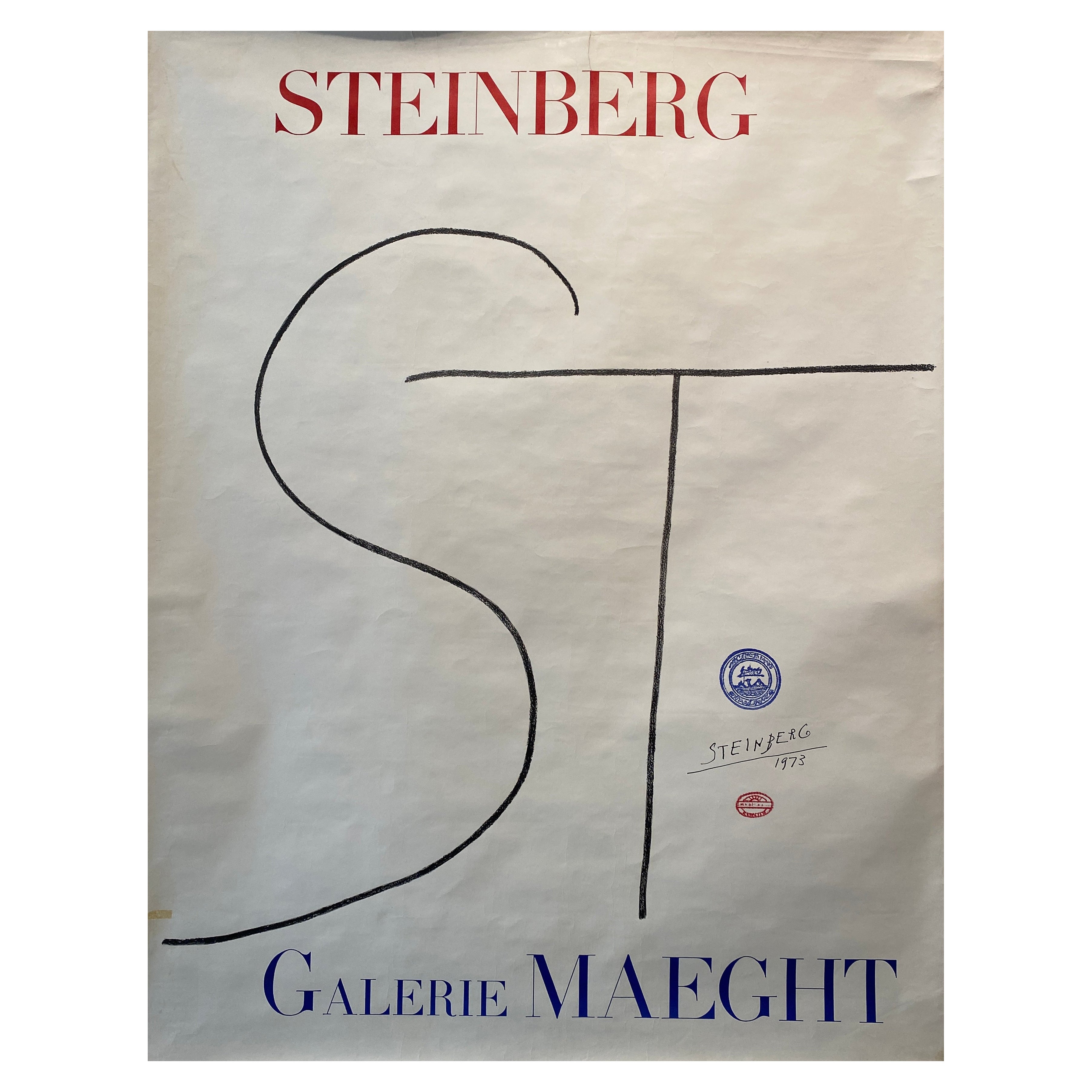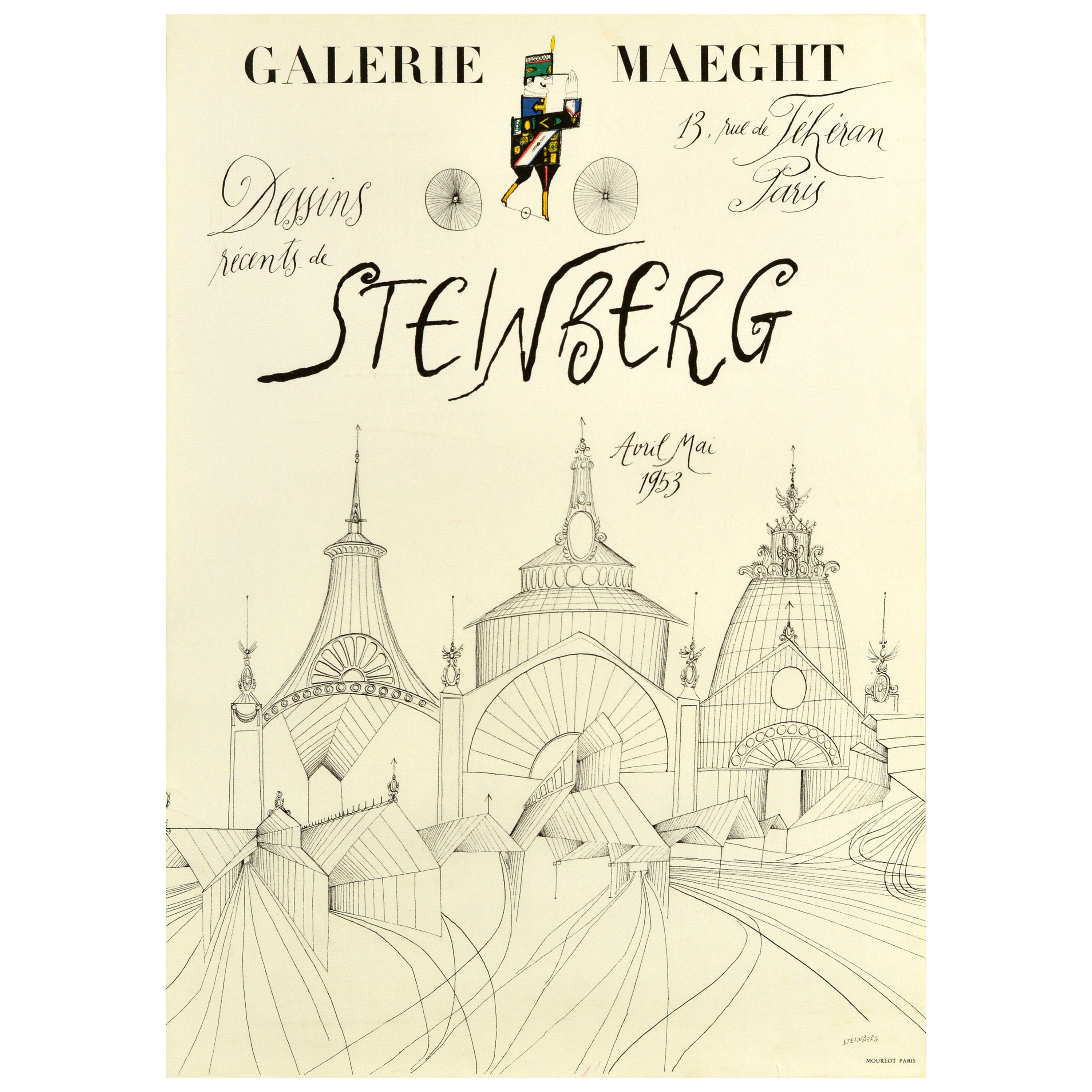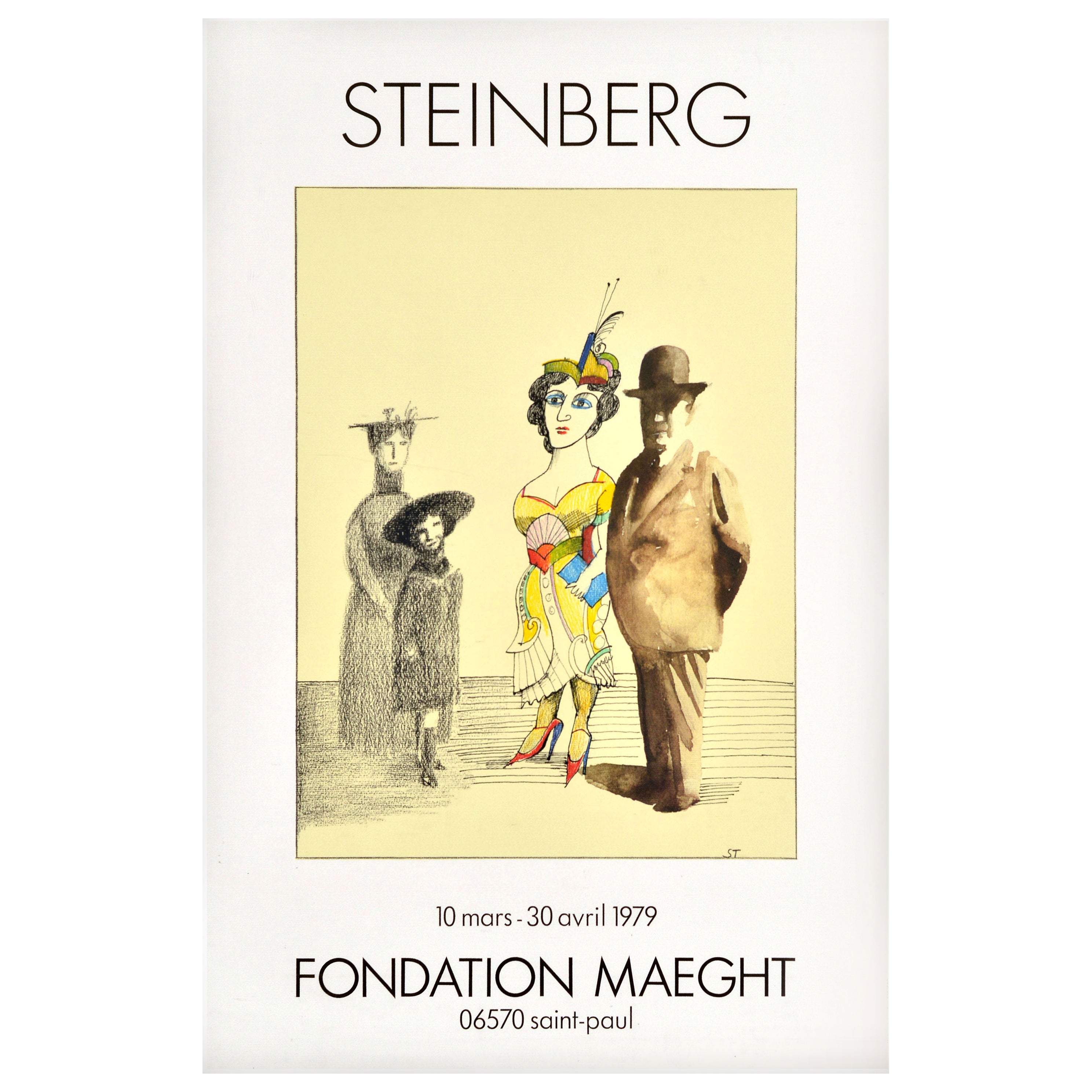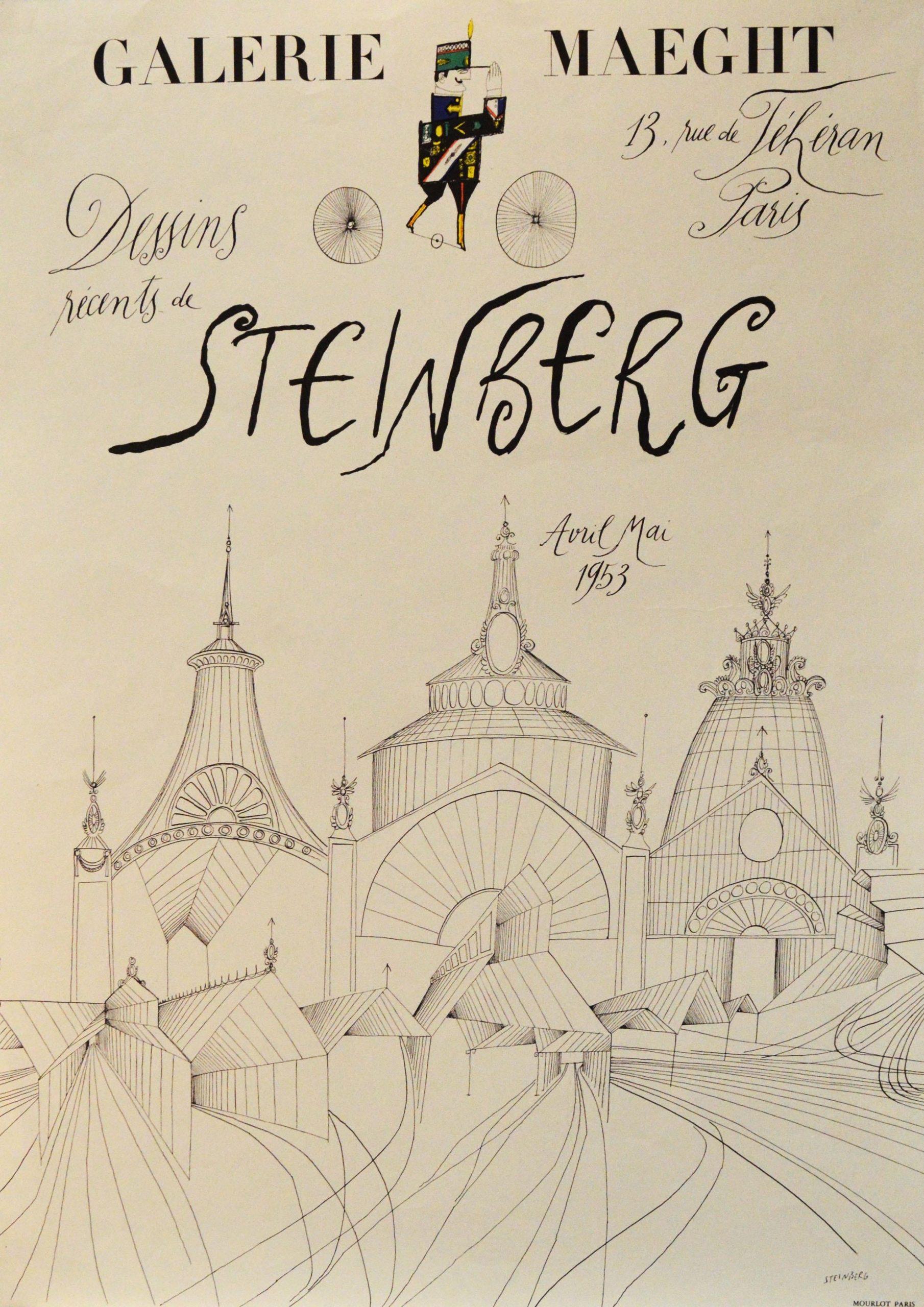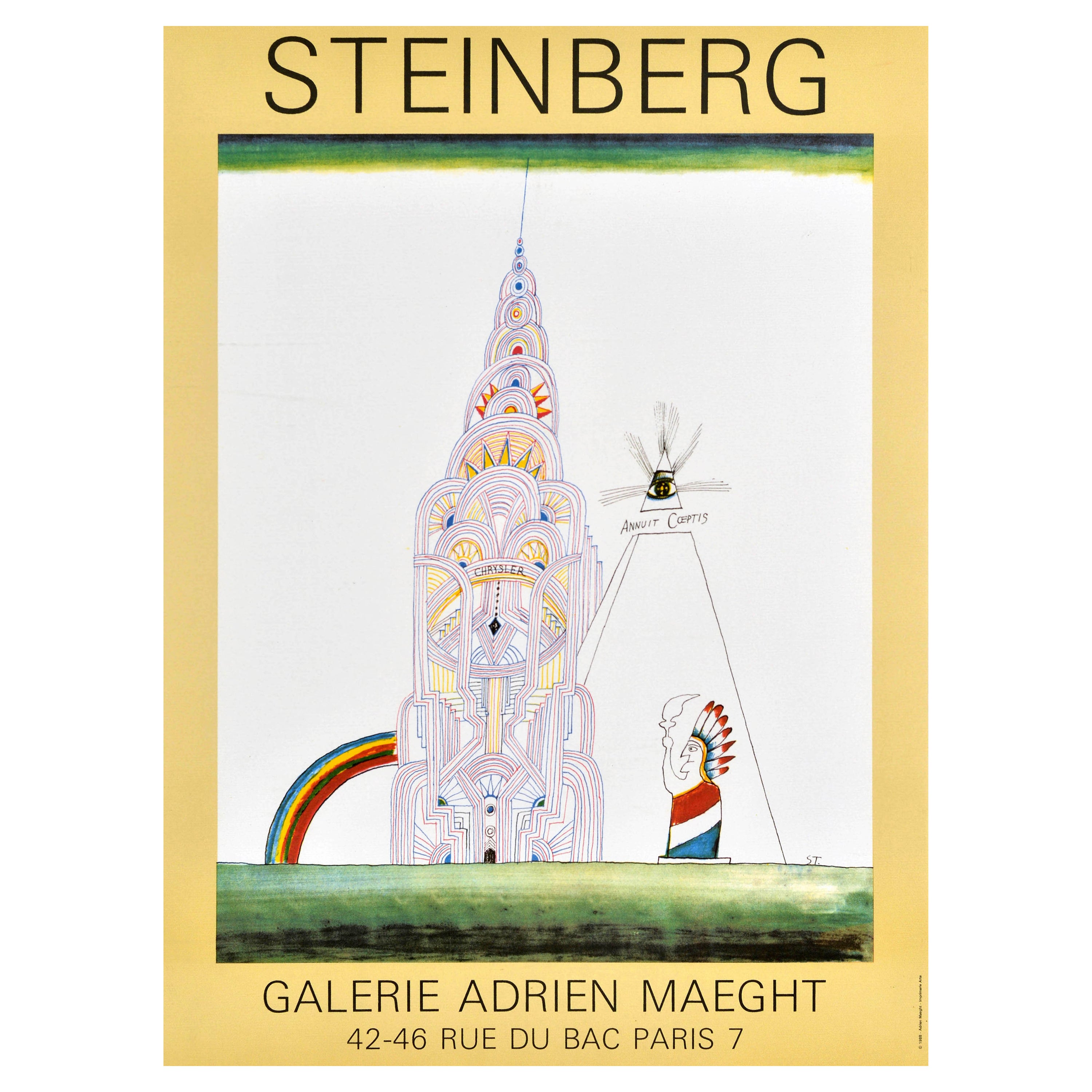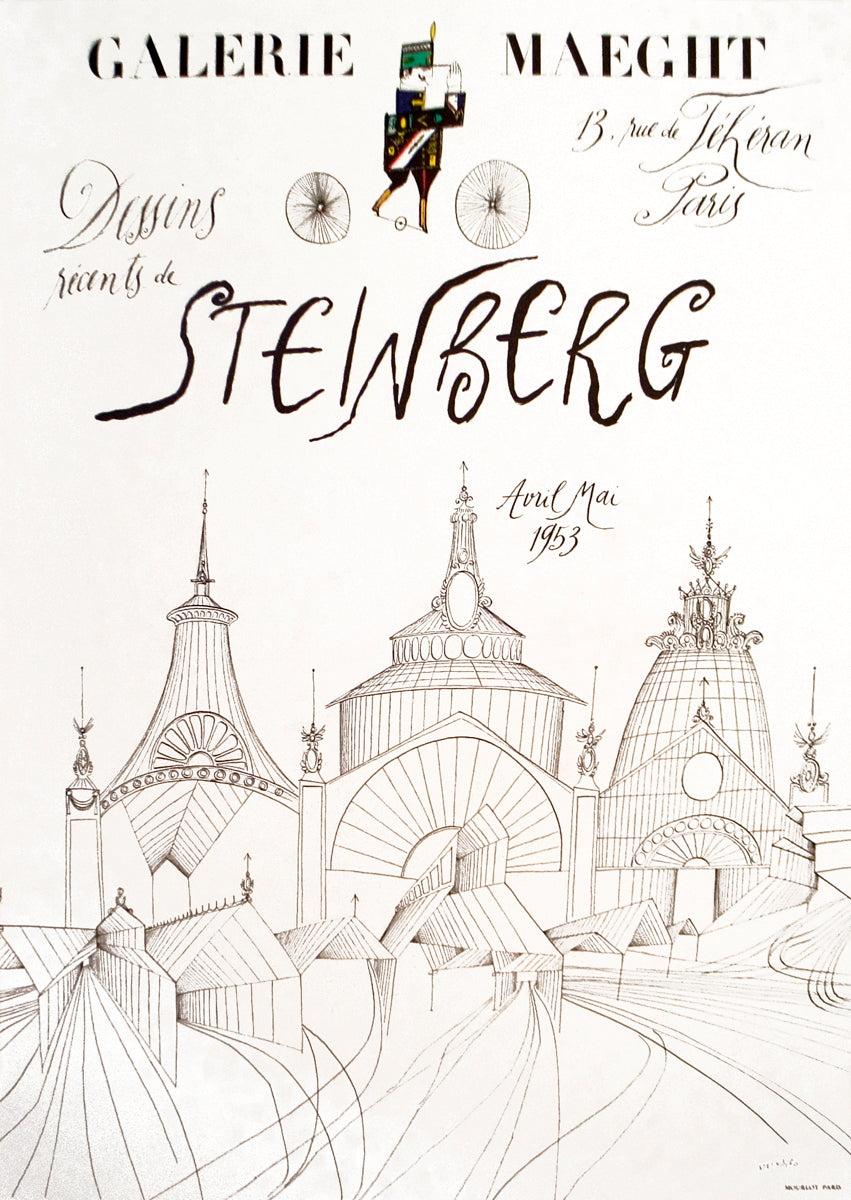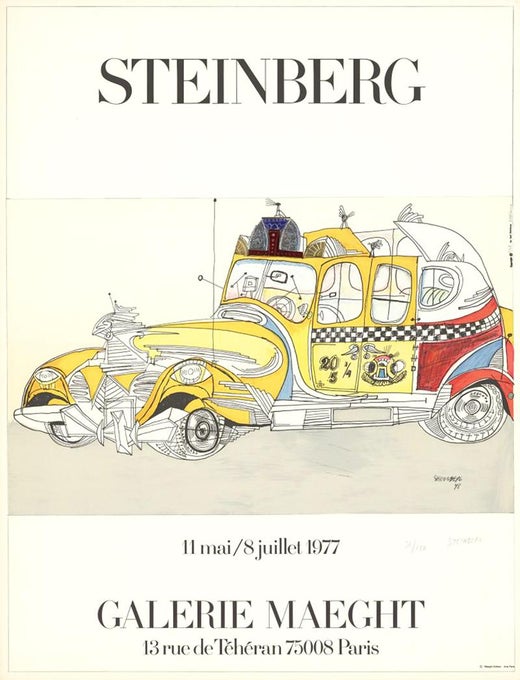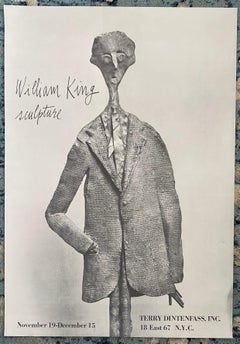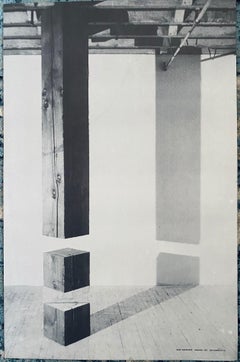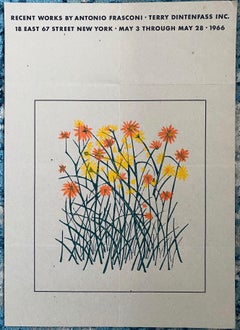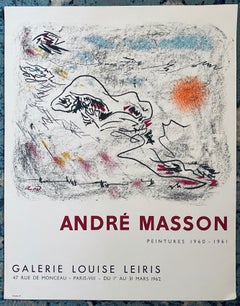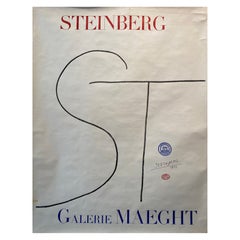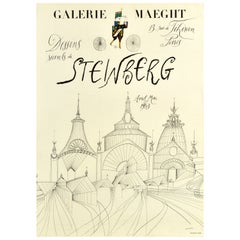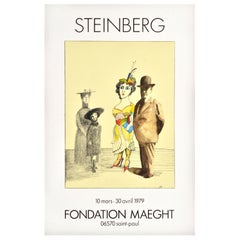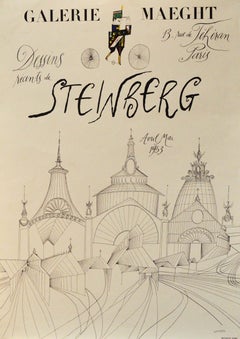Items Similar to Vintage Poster Saul Steinberg Galerie Maeght Paris France
Want more images or videos?
Request additional images or videos from the seller
1 of 9
Saul SteinbergVintage Poster Saul Steinberg Galerie Maeght Paris France1971
1971
$650
£490.93
€567.37
CA$911.72
A$1,013.93
CHF 530.74
MX$12,368.66
NOK 6,668.98
SEK 6,273.04
DKK 4,235.05
About the Item
SAUL STEINBERG (American 1914-1999) Via Air Mail Geometric Design Lithograph. Sheet: 21 1/2 x 28 inches; Frame: 22 1/4 x 29 inches. Plate signed and dated l/r with sticker upper right corner.
Saul Steinberg (June 15, 1914 – May 12, 1999) was a Romanian and American cartoonist and illustrator, best known for his work for The New Yorker, most notably View of the World from 9th Avenue. He described himself as "a writer who draws".
Steinberg was born in Râmnicu Sărat, Buzău County, Romania to a family of Jewish descent. In 1932, he entered the University of Bucharest. In 1933, he enrolled at the Politecnico di Milano to study architecture; he received his degree in 1940. In 1936, he began contributing cartoons to the humor newspaper Bertoldo. Two years later, the anti-Semitic racial laws promulgated by the Fascist government forced him to start seeking refuge in another country.
In 1941, he fled to the Dominican Republic, where he spent a year awaiting a US visa. By then, his drawings had appeared in several US periodicals; his first contribution to The New Yorker was published in October 1941. Steinberg arrived in New York City in July 1942; within a few months he received a commission in the US Naval Reserve and was then seconded to the Office of Strategic Services (OSS). He worked for the Morale Operations division in China, North Africa, and Italy. Shipped back to Washington in 1944, he married the Romanian-born painter Hedda Sterne.
After World War II, Steinberg continued to publish drawings in The New Yorker and other periodicals, including Fortune, Vogue, Mademoiselle, and Harper’s Bazaar At the same time, he embarked on an exhibition career in galleries and museums. In 1946, he was included in the critically acclaimed “Fourteen Americans” show at The Museum of Modern Art, New York, exhibiting along with Arshile Gorky, Isamu Noguchi, and Robert Motherwell, among others. Steinberg went on to have more than 80 one-artist shows in galleries and museums throughout the US, Europe, and South America. He was affiliated with the Betty Parsons and Sidney Janis galleries in New York and the Galerie Maeght in Paris. Since 1982, he has been represented by The Pace Gallery. A dozen museums and institutions have in-depth collections of his work, and examples are included in the holdings of more than eighty other public collections.
Steinberg’s long, multifaceted career encompassed works in many media and appeared in different contexts. In addition to magazine publications and gallery art, he produced advertising art, photoworks, textiles, stage sets, and murals. Given this many-leveled output, his work is difficult to position within the canons of postwar art history. He himself defined the problem: “I don’t quite belong to the art, cartoon or magazine world, so the art world doesn’t quite know where to place me.”
Select Bibliography
Iain Topliss, The Comic Worlds of Peter Arno, William Steig, Charles Addams, and Saul Steinberg. Baltimore: The Johns Hopkins University Press, 2005.
Joel Smith, with an introduction by Charles Simic, Saul Steinberg: Illuminations. New Haven and London: Yale University Press, 2006.
Saul Steinberg: L’Écriture visuelle. Strasbourg: Musée Tomi Ungerer, 2009.
Mario Tedeschini Lalli, “Descent from Paradise: Saul Steinberg’s Italian Years, 1933-1941.” Published in Issues in Contemporary Jewish History, no. 2, October 2011.
Bair, Deidre. Saul Steinberg: A Biography. Nan A. Talese/Doubleday (2012)
Corrections to Deirdre Bair, Saul Steinberg: A Biography
Melissa Renn, Andreas Prinzing, Iain Topliss, et al., Saul Steinberg: The Americans. Cologne: Museum Ludwig, 2013
Will Norman, Transatlantic Aliens: Modernism, Exile, and Culture in Midcentury America. Baltimore: Johns Hopkins University Press, 2016. Chapter 5, “Saul Steinberg’s Vanishing Trick.”
Mario Tedeschini Lalli, “Descent from Paradise: Saul Steinberg’s Italian Years, 1933-1941,” Published in Quest: Issues in Contemporary Jewish History, no. 2, October 2011.
Select Collections
MoMA NYC
The Saul Steinberg Foundation
The Art Institute of Chicago,
The National Gallery of Art,
Smithsonian American Art Museum,
Hirshhorn Museum and Sculpture Garden,
Yale University Art Gallery
Whitney Museum of American Art,
Library of Congress
Menil Collection
The Museum of Modern Art
Pace Gallery
Condé Nast Collection
Adam Baumgold Gallery
Cooper-Hewitt Museum
- Creator:Saul Steinberg (1914-1999, American)
- Creation Year:1971
- Dimensions:Height: 25 in (63.5 cm)Width: 18.5 in (46.99 cm)
- Medium:
- Movement & Style:
- Period:
- Condition:minor creasing.
- Gallery Location:Surfside, FL
- Reference Number:1stDibs: LU38214399562
Saul Steinberg
Saul Steinberg was a Romanian American artist, best known for his work for The New Yorker, most notably View of the World from 9th Avenue. He described himself as "a writer who draws
About the Seller
4.9
Platinum Seller
Premium sellers with a 4.7+ rating and 24-hour response times
Established in 1995
1stDibs seller since 2014
1,799 sales on 1stDibs
Typical response time: <1 hour
- ShippingRetrieving quote...Shipping from: Surfside, FL
- Return Policy
Authenticity Guarantee
In the unlikely event there’s an issue with an item’s authenticity, contact us within 1 year for a full refund. DetailsMoney-Back Guarantee
If your item is not as described, is damaged in transit, or does not arrive, contact us within 7 days for a full refund. Details24-Hour Cancellation
You have a 24-hour grace period in which to reconsider your purchase, with no questions asked.Vetted Professional Sellers
Our world-class sellers must adhere to strict standards for service and quality, maintaining the integrity of our listings.Price-Match Guarantee
If you find that a seller listed the same item for a lower price elsewhere, we’ll match it.Trusted Global Delivery
Our best-in-class carrier network provides specialized shipping options worldwide, including custom delivery.More From This Seller
View AllVintage Lithograph Poster William King Terry Dintenfass Gallery NYC
By William King (b.1925)
Located in Surfside, FL
Sculptor William King is widely renowned for his signature flattened and stilt-legged figures, gesturing dramatically. Humorous and rife with social commentary, his work first offered an alternative to Abstract Expressionism in the 1950s, then to Minimalism and conceptual art in the 1960s and 1970s. Through one radical art historical shift after another, King has maintained his commitment to the figure and social realism. Working with aluminum and vinyl, he arranges his painted figures in configurations that transform various social activities into satirical or fantastic situations. A man in a business suit with hands in his pockets is a recurring figure throughout his work.
King was born in Jacksonville, Florida, in 1925, and grew up in Coconut Grove, Miami. After attending the University of Florida between 1942 and 1944, he came to New York in 1945, enrolling that year at Cooper Union and graduating in 1948. The following year he went to Rome on a Fulbright scholarship. Beginning in 1953, he taught for three years at the Brooklyn Museum Art School. He has also taught at the University of California, Berkeley, and elsewhere. He is a member of the American Academy of Arts and Letters, and was President of the National Academy of Design between 1994 and 1998. He is the father of Eli King and Amy King, and lives with his wife, Connie Fox...
Category
Late 20th Century American Modern Prints and Multiples
Materials
Lithograph
Israeli Contemporary Vintage Lithograph Poster
Located in Surfside, FL
Buky Schwartz (pronounced BOO-kie) (Hebrew: בוקי שוורץ; June 16, 1932 – September 1, 2009, Tel Aviv) was an Israeli sculptor and video artist.
Moshe (Buky) Schwartz was born in Jer...
Category
Late 20th Century Contemporary Prints and Multiples
Materials
Lithograph
1966 Vintage Lithograph Poster Antonio Frasconi Terry Dintenfass Gallery NYC
Located in Surfside, FL
Antonio Frasconi (28 April 1919 in Montevideo, Uruguay – 8 January 2013 in Norwalk, CT, USA) was an Uruguayan - American visual artist, best known for his woodcuts. He was raised in ...
Category
1960s American Modern Prints and Multiples
Materials
Lithograph
French Abstract Surrealist Vintage Lithograph Mourlot Poster Andre Masson
By André Masson
Located in Surfside, FL
André-Aimé-René Masson (4 January 1896 – 28 October 1987) was a French artist.
Masson was born in Balagny-sur-Thérain, Oise, but when he was eight his father's work took the family ...
Category
Mid-20th Century Surrealist Paintings
Materials
Lithograph
Vintage Poster Bold Paris Berlin 1900-1930 Pompidou Center Polish Graphic Artist
By Roman Cieslewicz
Located in Surfside, FL
Roman Cieślewicz (born 1930 13 January in Lwów Poland now Lviv Ukraine - died 1996 21 January in Paris, France) was a Polish (naturalized French) graphic artist and photographer.
From 1943 to 1946 he attended the School of Artistic Industry in Lvov and from 1947 to 1949 attended the Krakow's Fine Arts Lycee. He studied at Kraków Academy of Fine Arts from 1949 to 1955. He was artistic editor of "Ty i Ja" monthly (Warsaw) 1959-1962. In 1963 he moved to France and naturalized in 1971. He worked as art director of Vogue, Elle (1965-1969) and Mafia - advertising agency (1969-1972) and was artistic creator of Opus International (1967-1969), Kitsch (1970-1971) and Cnac-archives (1971-1974). Taught at the Ecole Supérieure d'Arts Graphiques (ESAG) in Paris. In 1976 he produced his "review of panic information" - "Kamikaze"/No. 1/ published by Christian Bourgois. Folon. In 1991 he produced "Kamikaze 2" with Agnes B. He took part in numerous group exhibitions of graphic, poster and photographic art and was a member of AGI (Alliance Graphique Internationale).
He designed a famous 1960s Polish Cyrk Circus Dog Poster as well as a Pop art superman cover for Opus magazine and a Charlie Chaplin poster...
Category
1970s Constructivist Abstract Prints
Materials
Offset
Ben Shahn Original Hand Signed Litho WPA Artist Rilke Poem Lithograph Portfolio
By Ben Shahn
Located in Surfside, FL
"To Days of Childhood That are Still Unexplained". It depicts six female silhouette figures in long dresses or coats against a blue and pastel purple background. From the Rainier Ma...
Category
1950s American Modern Figurative Prints
Materials
Lithograph
You May Also Like
Original Exhibition Poster, Saul Steinberg for Galerie Maeght 1973
By Saul Steinberg
Located in Melbourne, Victoria
Saul Steinberg was a Romanian-born American artist, best known for his work for The New Yorker, most notably View of the World from 9th Avenue. He described himself as "a writer who ...
Category
Vintage 1970s French Modern Posters
Materials
Paper
Original Vintage Art Exhibition Poster Saul Steinberg Dessins Recent Drawings
By Saul Steinberg
Located in London, GB
Original vintage art exhibition poster for the Recent Drawings by Steinberg held at Galerie Maeght Paris in April and May 1953 - Dessins recents...
Category
Vintage 1950s French Posters
Materials
Paper
Original Vintage Art Exhibition Advertising Poster Steinberg Fondation Maeght
By Saul Steinberg
Located in London, GB
Original vintage advertising poster for an art exhibition by Steinberg at Fondation Maeght 06570 Saint-Paul from 10 March to 20 April 1979 featuring an illustration of silhouettes of a lady and child in grey and a man wearing a suit and hat in brown with a lady in a colourful yellow, white, blue and red dress and hat, wearing heeled shoes and holding a blue handbag...
Category
Vintage 1970s French Posters
Materials
Paper
Dessins Récents de Steinberg- Gallerie Maeght. Published by Mourlot, Paris.
By Saul Steinberg
Located in Chesterfield, MI
SAUL STEINBERG (Romanian-American, 1914-1999)
Dessins Récents de Steinberg, Gallerie Maeght, 13, Rue de Téhéran, Paris, Avril, Mai 1953.
Event Poster
2...
Category
Late 20th Century More Prints
Materials
Lithograph
Original Vintage Art Advertising Poster Saul Steinberg Chrysler Building Maeght
By Saul Steinberg
Located in London, GB
Original vintage advertising poster for an art exhibition by Steinberg at Galerie Adrien Maeght featuring an illustration of a Native American silhouette in the shape of the Statue of Liberty holding a torch wearing a red, white and blue feathered headdress, looking towards the iconic Art Deco Chrysler Building depicted in colourful lines and shapes with the Eye of Providence at the top of a pyramid and the motto of the Great Seal of the United States...
Category
Vintage 1980s French Posters
Materials
Paper
Saul Steinberg 'Galerie Maeght 1953'- Lithograph
By Saul Steinberg
Located in Brooklyn, NY
This restrike of Saul Steinberg’s 1953 poster, titled Dessins Récents, was presented at Galerie Maeght, located at 13 Rue Téheran in Paris. The poster, initially created to showcase ...
Category
Late 20th Century Prints and Multiples
Materials
Lithograph
More Ways To Browse
An American In Paris Poster
War Poster Italian
Vintage French Posters
South America Vintage Posters
Vintage French Screens
Noguchi Signed
Andreas Maier
Mademoiselle Vintage
Motherwell Posters
Robert Motherwell Poster
Chinese Republic Plate
Peter Arno
Anti Fascist Posters
Hedda Sterne
Vegetables Matisse
Vintage Art Supplies 1940s
Vintage Cat Bank
Vintage German Banjo
